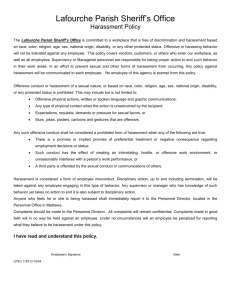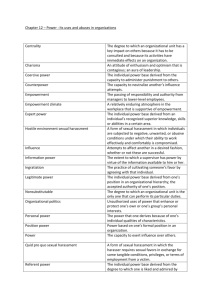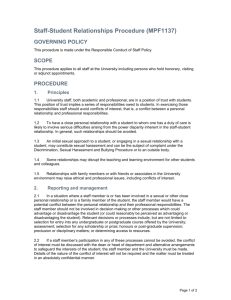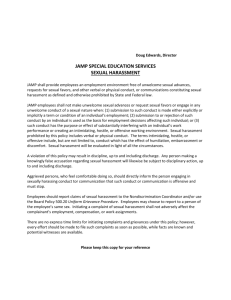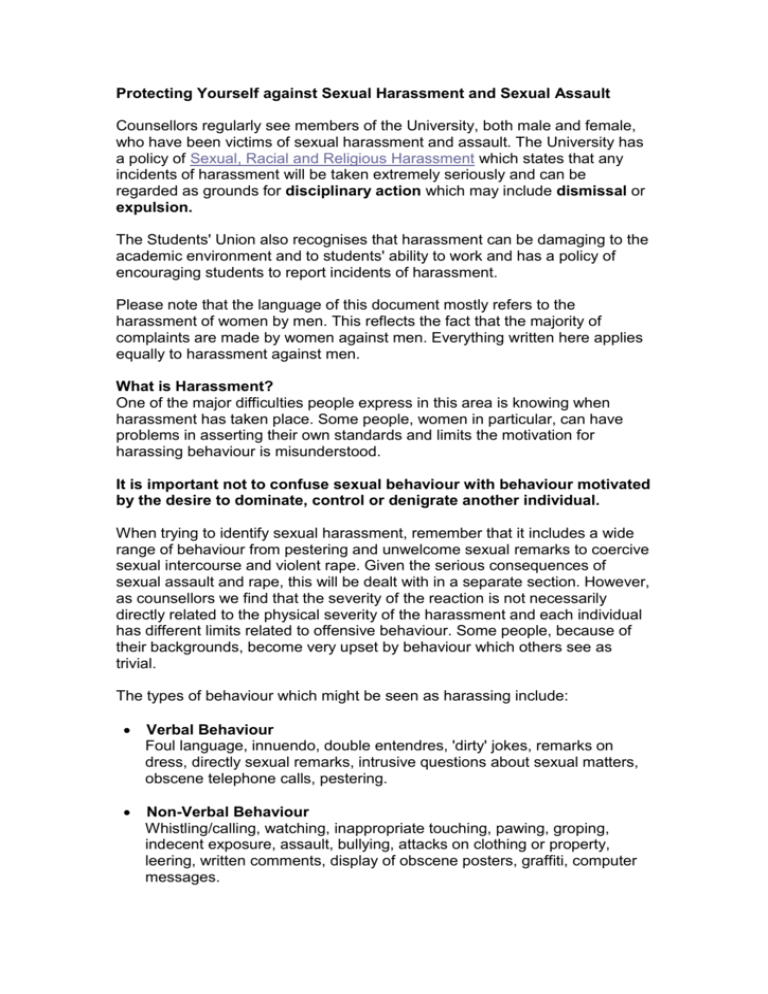
Protecting Yourself against Sexual Harassment and Sexual Assault
Counsellors regularly see members of the University, both male and female,
who have been victims of sexual harassment and assault. The University has
a policy of Sexual, Racial and Religious Harassment which states that any
incidents of harassment will be taken extremely seriously and can be
regarded as grounds for disciplinary action which may include dismissal or
expulsion.
The Students' Union also recognises that harassment can be damaging to the
academic environment and to students' ability to work and has a policy of
encouraging students to report incidents of harassment.
Please note that the language of this document mostly refers to the
harassment of women by men. This reflects the fact that the majority of
complaints are made by women against men. Everything written here applies
equally to harassment against men.
What is Harassment?
One of the major difficulties people express in this area is knowing when
harassment has taken place. Some people, women in particular, can have
problems in asserting their own standards and limits the motivation for
harassing behaviour is misunderstood.
It is important not to confuse sexual behaviour with behaviour motivated
by the desire to dominate, control or denigrate another individual.
When trying to identify sexual harassment, remember that it includes a wide
range of behaviour from pestering and unwelcome sexual remarks to coercive
sexual intercourse and violent rape. Given the serious consequences of
sexual assault and rape, this will be dealt with in a separate section. However,
as counsellors we find that the severity of the reaction is not necessarily
directly related to the physical severity of the harassment and each individual
has different limits related to offensive behaviour. Some people, because of
their backgrounds, become very upset by behaviour which others see as
trivial.
The types of behaviour which might be seen as harassing include:
Verbal Behaviour
Foul language, innuendo, double entendres, 'dirty' jokes, remarks on
dress, directly sexual remarks, intrusive questions about sexual matters,
obscene telephone calls, pestering.
Non-Verbal Behaviour
Whistling/calling, watching, inappropriate touching, pawing, groping,
indecent exposure, assault, bullying, attacks on clothing or property,
leering, written comments, display of obscene posters, graffiti, computer
messages.
Attitudes
Bullying, insulting, demeaning attitudes can be hard to identify in explicit
behaviour.
Trust your feelings: if you sense that a person's behaviour is motivated by
favouritism or lack of respect related to sex or is threatening in some way, act
cautiously, talk things over with a friend, and do not allow yourself to be
manipulated into a compromising or dangerous situation through fear of
being seen as naive or prudish.
To reiterate:
sexual harassment is any behaviour based on sex which emphasises
sexual status over status as an individual, colleague or student
sexual attention becomes sexual harassment if it is persisted in once it
has been made clear that it is regarded by the recipient as offensive
one incident of harassment may constitute sexual harassment if
sufficiently serious
It is the unwanted nature of the conduct which distinguishes sexual
harassment from friendly behaviour, which is welcome or mutual, (Equal
Opportunities Commission October 1993.)
Responding to Sexual Harassment
Harassment can stimulate very difficult and uncomfortable feelings. Victims
can feel intimidated, afraid, embarrassed, threatened, angry or become very
passive. It is common for the victim to take responsibility for the fact that
someone is behaving unreasonably toward them and feel inappropriate guilt
and low self-esteem.
It is important to remember that you have the right to set limits and to state
those limits. No-one has the right to impose on you behaviour which you find
offensive. So, if you find someone's attitudes or activities distasteful SAY SO
and say so clearly. Look the person in the eye and tell them directly. For
example, "l do not enjoy this kind of conversation and I would prefer it if you
did not speak to me in this way". "I do not enjoy you touching me in this way
and would prefer you to stop".
There are many techniques of assertive communication which might be
helpful in this situation and the University Counselling and Guidance Service
provides workshop training on Assertive Communication. However, the most
important influence is your attitude.
Refuse to be intimidated
Acknowledge your right to set limits
Learn to state your limits clearly
Ask for help if you need it
Do not suffer in silence: No-one deserves to be harassed.




